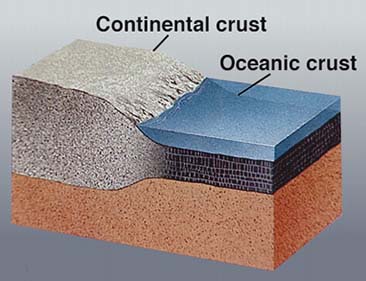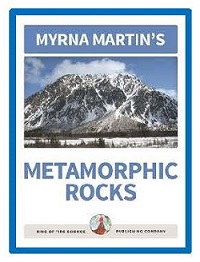What is the Earth's Crust?
The Earth's crust
The crust of he Earth is the outermost layer of our planet. It is less than 1% of the Earth's volume. The crust and the mantle contain different types of rocks making them chemically different.
The crust contains of a variety of rocks. Igneous rocks, sedimentary rocks, and metamorphic rocks are the main categories of rocks found on the Earth's surface. The upper mantle rocks are primarily peridotite.

Continental and oceanic crust, USGS
The Moho Boundary
The Mohorovicic Discontinuity
The Mohorovicic Discontinuity or MOHO boundary was named for the Croatian seismologist who discovered it. The speed of earthquake waves led to the discovery of the boundary between the Earths crust and the mantle. The Mohorovicic Discontinuity (MOHO) is the boundary between these two layers. It is called a discontinuity because the Earths crust varies in depth. The Moho boundary is the name most people use for the boundary between the crust and the mantle.
Varying depth of the MOHO boundary
The depth of the MOHO boundary varies depending if it is under a mountain range in the continental crust, the valleys and plains of the continents, or the ocean crusts created at divergent boundaries. The MOHO beneath the plain near the Himalayas averages about 32 km. The depth increases to a depth of 37 to 52 km beneath the Himalayas. The boundary averages about 7 km beneath the seafloors.
The Oceans crust
The oceanic crust is between five and ten kilometers thick. Separating plates form a low pressure area where molten rock collects in magma chambers. As two oceanic crusts separate basalt flows out onto the ocean floor creating new oceanic crust. Basalt, diabase and gabbro are the primary rocks found in the oceanic crust. These rocks are iron rich, dense and heavier than continental crust rocks.

Metamorphic Rocks is about the rocks on the crust of the Earth that have recrystallized into new rocks from older rocks. The book includes chapters on regional and contact metamorphism, marble, Himalayan Mountains, and ancient mountains. Myrna

Click for More Information and to Order
Continental Crust
When a continental crust and an oceanic crust meet they form a subduction zone. The heavier oceanic crust is forced beneath the lighter continental crust where it subducts into the lithosphere and melts. The oceanic crust is much younger than continental crust that is not destroyed when it collides with another tectonic plate.
The Continental Crustal Rocks
The continental crust contains a wide variety of rocks. Two thousand different minerals have been identified in the crust. Only twenty of these minerals are common. Just ten of the two thousand minerals in the crust combine together in rocks to make up 90% of the crust.
Silicate minerals
Ten minerals that make up 90% of the crust are all silicates because all contain silicon and oxygen. Quartz is pure silicon and oxygen. The rest of the silicate minerals include additional elements in the minerals structure.
The silicate minerals that make up the continents are lighter than the iron-rich minerals that form in oceanic crust which are derived from the upper mantle.
Floating crusts on the asthenosphere
Both the oceanic crust and the continental crust "float" on the asthenosphere that lies beneath the lithosphere. Continental crusts "floats" on the asthenosphere similar to an ice cube floating in water. When they collide with another continental crust they smash together forming great mountain chains instead of being recycled. The continents rise above and sink below the oceanic crust.
KIDS FUN Science Bookstore
Check out Myrna Martin's award winning textbooks, e-books, videos and rock sets. The Kids Fun Science Bookstore covers a wide range of earth science topics. Click here to browse.










